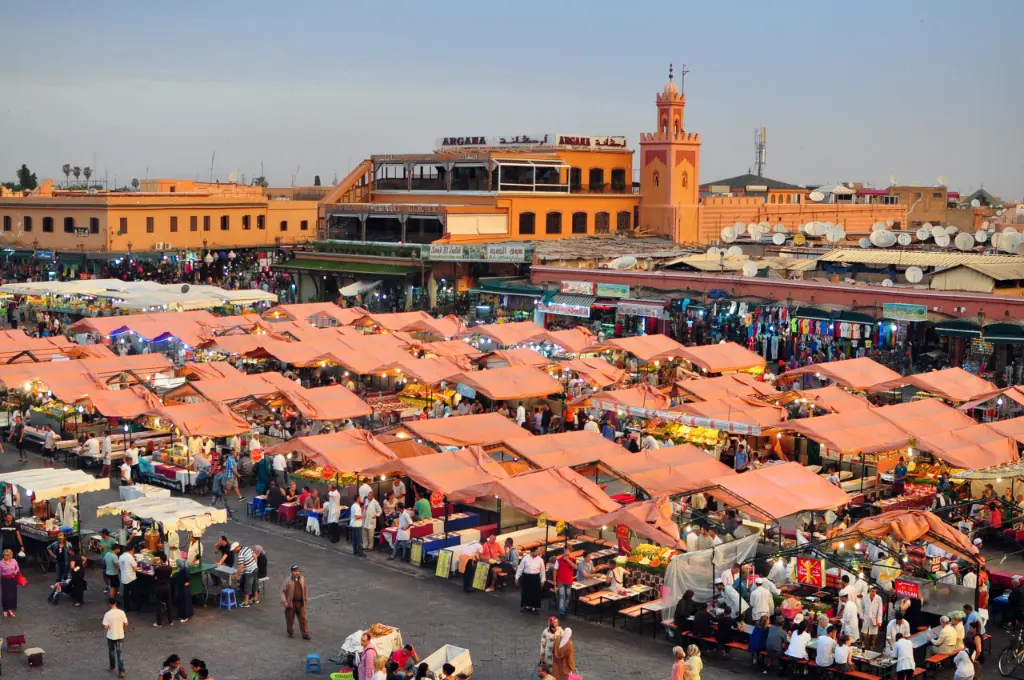The Vibrant Heart of Marrakech North Africa
Marrakech, often referred to as the “Red City,” is a mesmerizing blend of history, culture, and modernity. Situated in Morocco, this city captures the essence of North Africa with its vibrant medina, stunning palaces, and bustling souks. This article explores why Marrakech is a must-visit destination, offering insights into its rich heritage and contemporary allure.
What Makes Marrakech a Must-Visit Destination?
Marrakech, one of Morocco’s four imperial cities, is a treasure trove of cultural and historical gems. The city’s unique blend of the ancient and the modern offers an unparalleled experience for tourists. From the bustling souks to the serene riads, Marrakech is a city that never fails to enchant its visitors.
Marrakech’s strategic location in North Africa makes it a gateway to exploring the region’s diverse landscapes and cultures. Its historical significance, coupled with its vibrant contemporary scene, makes it a magnet for travelers from around the world.
Exploring the Medina: The Heart of Marrakech North Africa
The Medina of Marrakech is a UNESCO World Heritage Site and the beating heart of the city. This walled city, with its narrow alleyways and bustling markets, offers a glimpse into the traditional Moroccan way of life. The Medina is home to numerous historical sites, including the Koutoubia Mosque, which stands as a testament to Marrakech’s rich Islamic heritage.
Walking through the Medina, you’ll encounter the iconic souks where artisans sell everything from handcrafted jewelry to traditional Moroccan carpets. The Medina is not just a market; it’s a cultural experience that immerses visitors in the sights, sounds, and scents of Morocco.
The Allure of Marrakech’s Souks: A Shopper’s Paradise
Marrakech’s souks are a labyrinth of narrow streets lined with shops and stalls selling an array of goods. From vibrant textiles to intricate pottery, the souks are a shopper’s paradise. Each section of the souk is dedicated to a specific type of product, making it easy for visitors to find what they are looking for.
One of the most famous souks is the Souk Semmarine, known for its leather goods and traditional Moroccan slippers. Exploring the souks is not just about shopping; it’s about experiencing the hustle and bustle of Marrakech’s market culture.
Unveiling the History: Almoravid and Almohad Dynasties
Marrakech’s history is deeply intertwined with the Almoravid and Almohad dynasties. The city was founded in 1070 by the Almoravid king Yusuf ibn Tashfin and later flourished under the Almohad Caliphate. These dynasties left an indelible mark on the city’s architecture and culture.
The Almoravid influence is evident in the design of the Koutoubia Mosque, while the Almohad legacy can be seen in the city’s fortified walls and gates. Understanding the historical significance of these dynasties provides a deeper appreciation of Marrakech’s rich cultural heritage.
Majestic Palaces: Bahia Palace and El Badi Palace
Marrakech is home to some of Morocco’s most stunning palaces, including the Bahia Palace and El Badi Palace. The Bahia Palace, built in the late 19th century, is a masterpiece of Moroccan architecture with its intricate tilework and lush gardens.
El Badi Palace, once a symbol of the sultan’s wealth and power, now stands as an impressive ruin. Visitors can explore the palace’s vast courtyards and underground passages, imagining the grandeur that once was.
Iconic Landmarks: Koutoubia Mosque and Jemaa el-Fna
The Koutoubia Mosque is one of Marrakech’s most iconic landmarks. Its towering minaret dominates the city’s skyline, serving as a symbol of Marrakech’s rich Islamic heritage. The mosque, built in the 12th century, is a prime example of Almohad architecture.
Jemaa el-Fna, the main square of Marrakech, is another must-see attraction. This lively square comes alive at night with food stalls, musicians, and street performers. It’s a place where tradition and modernity meet, offering a unique glimpse into Marrakech’s vibrant culture.
The Influence of Berber Culture in Marrakech
Berber culture plays a significant role in Marrakech’s identity. The Berbers, indigenous to North Africa, have greatly influenced the city’s art, architecture, and traditions. Berber craftsmanship can be seen in the intricate designs of carpets, jewelry, and pottery sold in the souks.
Visitors can learn more about Berber culture at the Maison de la Photographie, which houses an extensive collection of photographs documenting the Berber way of life. The influence of Berber culture is also evident in the cuisine, with dishes like tagine and couscous being staples in Moroccan homes.
Modern Marrakech: Gueliz and Beyond
While the Medina offers a glimpse into Marrakech’s past, the district of Gueliz showcases the city’s modern side. Gueliz is known for its trendy cafes, chic boutiques, and contemporary art galleries. It’s a stark contrast to the traditional Medina, offering visitors a taste of modern Moroccan life.
Gueliz is also home to the Yves Saint Laurent Museum and the Majorelle Garden, both of which celebrate the legacy of the famous designer who made Marrakech his second home. These attractions highlight the city’s blend of old and new, making Marrakech a dynamic and ever-evolving destination.
Nature’s Splendor: The Atlas Mountains and Majorelle Garden
Marrakech’s proximity to the Atlas Mountains offers visitors the chance to experience Morocco’s natural beauty. The Atlas Mountains provide a stunning backdrop to the city and are a popular destination for hiking and trekking. The Ourika Valley, located in the foothills of the Atlas, is a favorite spot for day trips from Marrakech.
The Majorelle Garden, designed by French painter Jacques Majorelle, is another oasis of tranquility in the city. This botanical garden, with its vibrant blue buildings and exotic plants, is a testament to Marrakech’s rich artistic heritage. The garden also houses the Berber Museum, which showcases artifacts from Morocco’s indigenous people.
Marrakech’s Role in Moroccan Tourism
честные казино с быстрыми выплатами
бездепозитные бонусы казино
играть в лучшем казино на деньги
база казино с бездепозитным бонусом
онлайн казино России
casino oyunu
Marrakech is a cornerstone of Moroccan tourism, attracting millions of visitors each year. Its unique blend of history, culture, and modernity makes it a top destination for travelers seeking an authentic Moroccan experience. The city’s international airport and well-developed infrastructure make it easily accessible from major cities around the world.
Marrakech’s role in tourism extends beyond its borders, as it serves as a gateway to exploring other parts of Morocco. From the Sahara Desert to the coastal city of Casablanca, Marrakech’s strategic location makes it an ideal starting point for a Moroccan adventure.





































